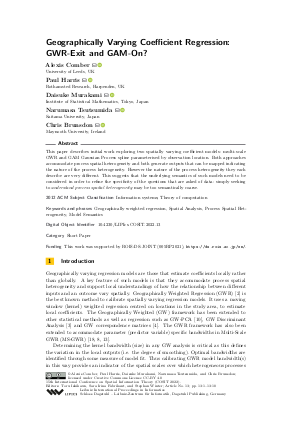Geographically Varying Coefficient Regression: GWR-Exit and GAM-On? (Short Paper)
Authors
Alexis Comber  ,
Paul Harris
,
Paul Harris  ,
Daisuke Murakami
,
Daisuke Murakami  ,
Narumasa Tsutsumida
,
Narumasa Tsutsumida  ,
Chris Brunsdon
,
Chris Brunsdon 
-
Part of:
Volume:
15th International Conference on Spatial Information Theory (COSIT 2022)
Part of: Series: Leibniz International Proceedings in Informatics (LIPIcs)
Part of: Conference: Conference on Spatial Information Theory (COSIT) - License:
 Creative Commons Attribution 4.0 International license
Creative Commons Attribution 4.0 International license
- Publication Date: 2022-08-22
File

PDF
LIPIcs.COSIT.2022.13.pdf
- Filesize: 1.54 MB
- 10 pages
Document Identifiers
Subject Classification
ACM Subject Classification
- Information systems
- Theory of computation
Keywords
- Geographically weighted regression
- Spatial Analysis
- Process Spatial Heterogeneity
- Model Semantics
Metrics
- Access Statistics
-
Total Accesses (updated on a weekly basis)
0Document
0Metadata
Abstract
This paper describes initial work exploring two spatially varying coefficient models: multi-scale GWR and GAM Gaussian Process spline parameterised by observation location. Both approaches accommodate process spatial heterogeneity and both generate outputs that can be mapped indicating the nature of the process heterogeneity. However the nature of the process heterogeneity they each describe are very different. This suggests that the underlying semantics of such models need to be considered in order to refine the specificity of the questions that are asked of data: simply seeking to understand process spatial heterogeneity may be too semantically coarse.
Cite As Get BibTex
Alexis Comber, Paul Harris, Daisuke Murakami, Narumasa Tsutsumida, and Chris Brunsdon. Geographically Varying Coefficient Regression: GWR-Exit and GAM-On? (Short Paper). In 15th International Conference on Spatial Information Theory (COSIT 2022). Leibniz International Proceedings in Informatics (LIPIcs), Volume 240, pp. 13:1-13:10, Schloss Dagstuhl – Leibniz-Zentrum für Informatik (2022)
https://doi.org/10.4230/LIPIcs.COSIT.2022.13
BibTex
@InProceedings{comber_et_al:LIPIcs.COSIT.2022.13,
author = {Comber, Alexis and Harris, Paul and Murakami, Daisuke and Tsutsumida, Narumasa and Brunsdon, Chris},
title = {{Geographically Varying Coefficient Regression: GWR-Exit and GAM-On?}},
booktitle = {15th International Conference on Spatial Information Theory (COSIT 2022)},
pages = {13:1--13:10},
series = {Leibniz International Proceedings in Informatics (LIPIcs)},
ISBN = {978-3-95977-257-0},
ISSN = {1868-8969},
year = {2022},
volume = {240},
editor = {Ishikawa, Toru and Fabrikant, Sara Irina and Winter, Stephan},
publisher = {Schloss Dagstuhl -- Leibniz-Zentrum f{\"u}r Informatik},
address = {Dagstuhl, Germany},
URL = {https://drops.dagstuhl.de/entities/document/10.4230/LIPIcs.COSIT.2022.13},
URN = {urn:nbn:de:0030-drops-168986},
doi = {10.4230/LIPIcs.COSIT.2022.13},
annote = {Keywords: Geographically weighted regression, Spatial Analysis, Process Spatial Heterogeneity, Model Semantics}
}
Author Details
Funding
This work was supported by ROIS-DS-JOINT (005RP2021), https://ds.rois.ac.jp/en/.
References
-
Chris Brunsdon and Alexis Comber. Opening practice: supporting reproducibility and critical spatial data science. Journal of Geographical Systems, 23(4):477-496, 2021.

-
Chris Brunsdon, A Stewart Fotheringham, and Martin E Charlton. Geographically weighted regression: a method for exploring spatial nonstationarity. Geographical Analysis, 28(4):281-298, 1996.

-
Chris Brunsdon, Stewart Fotheringham, and Martin Charlton. Geographically weighted discriminant analysis. Geographical Analysis, 39(4):376-396, 2007.

-
Alexis Comber, Chris Brunsdon, Martin Charlton, and Paul Harris. Geographically weighted correspondence matrices for local error reporting and change analyses: mapping the spatial distribution of errors and change. Remote Sensing Letters, 8(3):234-243, 2017.

-
Alexis Comber, Christopher Brunsdon, Martin Charlton, Guanpeng Dong, Richard Harris, Binbin Lu, Yihe Lü, Daisuke Murakami, Tomoki Nakaya, Yunqiang Wang, et al. A route map for successful applications of geographically weighted regression. Geographical Analysis, 0:1-24, 2022.

- Alexis Comber, Nick Malleson, Hang Nguyen Thi Thuy, Thanh Bui Quang, Minh Kieu, Hoang Huu Phe, and Paul Harris. Multiscale geographically weighted discriminant analysis. In GIScience 2021 Short Paper Proceedings, pages 17-32. Springer, 2021. URL: https://doi.org/10.25436/E2PP4F.
-
Ludwig Fahrmeir, Thomas Kneib, Stefan Lang, and Brian D Marx. Regression models. In Regression, pages 23-84. Springer, 2021.

-
A Stewart Fotheringham, Wenbai Yang, and Wei Kang. Multiscale geographically weighted regression (mgwr). Annals of the American Association of Geographers, 107(6):1247-1265, 2017.

-
Alan E Gelfand and Dipak K Dey. Bayesian model choice: asymptotics and exact calculations. Journal of the Royal Statistical Society: Series B (Methodological), 56(3):501-514, 1994.

-
Paul Harris, Chris Brunsdon, and Martin Charlton. Geographically weighted principal components analysis. International Journal of Geographical Information Science, 25(10):1717-1736, 2011.

-
Trevor J Hefley, Kristin M Broms, Brian M Brost, Frances E Buderman, Shannon L Kay, Henry R Scharf, John R Tipton, Perry J Williams, and Mevin B Hooten. The basis function approach for modeling autocorrelation in ecological data. Ecology, 98(3):632-646, 2017.

-
Stan Openshaw. Developing gis-relevant zone-based spatial analysis methods. Spatial analysis: modelling in a GIS environment, pages 55-73, 1996.

-
Taylor M Oshan, Ziqi Li, Wei Kang, Levi J Wolf, and A Stewart Fotheringham. mgwr: A python implementation of multiscale geographically weighted regression for investigating process spatial heterogeneity and scale. ISPRS International Journal of Geo-Information, 8(6):269, 2019.

-
PD Sampson, D Damian, and P Guttorp. Advances in modeling and inference for environmental processes with nonstationary spatial covariance. In GeoENV III - Geostatistics for Environmental Applications, pages 17-32. Springer, 2001.

-
Waldo R Tobler. A computer movie simulating urban growth in the detroit region. Economic geography, 46(sup1):234-240, 1970.

-
Levi John Wolf, Taylor M Oshan, and A Stewart Fotheringham. Single and multiscale models of process spatial heterogeneity. Geographical Analysis, 50(3):223-246, 2018.

-
Simon N Wood. Generalized additive models: an introduction with R. chapman and hall/CRC, 2006.

-
Wenbai Yang. An extension of geographically weighted regression with flexible bandwidths. PhD thesis, University of St Andrews, 2014.

